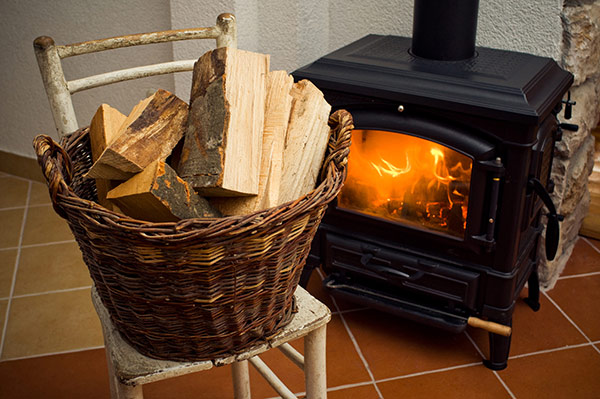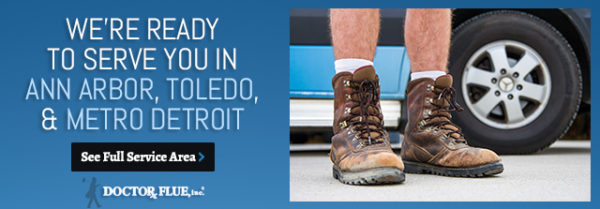
Wood stoves can add a cozy feel to any home. They can also provide heat during the colder months – often enough to heat entire rooms or sections of your home. This ability to reduce home heating costs is one of the many reasons homeowners consider the addition of a wood stove.
Whether your wood stove is your main source of heat, a supplemental heat source, or simply an addition to increase the ambiance in your home, there are some wood stove safety tips every homeowner should keep in mind.
Maintenance is Critical
Any homeowner can tell you that home maintenance is important and should be done regularly. This is true of wood stoves as well; after all it is an appliance that involves fire!
The first wood stove safety tip is something that should be done regularly: clean up and dispose of ashes when you are done using your wood stove. When you are finished burning and the ashes have cooled; they can be removed to a metal container. Water can be used to wet the ashes. If you have some tarnished silver, wet ashes make a great silver polish. Otherwise, ashes can be dumped somewhere safe, preferably away from vegetation. Many plants and bushes that thrive in acidic soil, such as rhododendron, won’t do well when ashes neutralize the acid in the soil.
Once the ashes are removed, use a wire brush to clean your wood stove. This process helps minimize deposits of creosote and soot which, if allowed to build up, can create a fire hazard. If you clean your wood stove after each use and make this part of the regular routine, it will become second nature and you’ll be off to a good start in your wood stove safety plan.
While cleaning after each use is effective, it’s also important that you schedule annual inspections for your stove and chimney. Deterioration in your stove or chimney can leave your home at risk for spreading fire. It is important to remember that basic chimney cleanings and inspections – annually at minimum - protect you and increase your wood stove safety.
Keep an Eye on the Stove
Like any fire, don’t leave it unsupervised. The door on a wood stove can give you a false sense of security. However, even in an enclosed wood stove, a fire can grow too large. For wood stove safety, or the safety of any fireplace, never leave a fire unattended.
Fire is often unpredictable, though even serious fire incidents can be stopped if you catch them immediately. However there are two things that can be even more unpredictable than fire: children and pets. Always keep a watchful eye on them and be sure they are kept away from the fire.
There may be an occasion when the fire starts to grow beyond what you feel is safe. If this occurs, use the dampers and seal the main door to try to starve the fire of oxygen.
Be Careful How You Start Your Fire
Just like being in a hurry on the road can cause traffic accidents, being in a hurry to start your fire can lead to serious situations. So another important wood stove safety tip is: don’t be impatient when starting a fire in a wood stove.
You may think that lighter fluid sounds like a quick way to kick start your fire. But lighter fluid is an unnecessary and extreme risk. It is formulated for use in an open air environment, not an enclosed wood stove. Not only does it have the potential to give a fire a trail to spread outside the stove, lighter fluid can vaporize in the stove faster than it can burn and cause an explosion.
Charcoal is not a good option either. The byproducts that are released from burning charcoal aren’t safe for indoor use.
Exercise patience and utilize safe fire starting options for optimum wood stove safety. Smart choices include fatwood, paper, dry kindling or wood chips.
Burn the Right Stuff
You may not give as much thought to what you burn in a wood stove because the door is closed. But a door doesn’t equal wood stove safety. Ultimately, the quality and safety of your fire is impacted the most by what you choose to burn.
It is a good idea to remember there are things you should never burn in a wood stove: garbage, plastic, and treated wood from construction. There could be lead, arsenic, even mercury in or on treated wood depending on when it was manufactured or painted. Burning these items can release toxic fumes which can be harmful to you, your family and the environment.
The best woods are dry and seasoned. If you have fresh wood that’s wet or green may eventually burn, but it won’t burn efficiently. Additionally, it will produce large volumes of smoke that can fill the room, make it difficult to breathe and damage your home and furniture.
Watch for Ventilation Issues
Wood stove safety isn’t complete without discussing the need to be safely and properly vented. The proper vent is as short as possible. The vent shouldn’t pass through any walls, floors or other obstructions, but exit safely into a chimney flue. This doesn’t mean that if you’re adding a wood stove to your existing home design you should try to “share” flues. The only time a wood stove should use an existing flue is if the previous appliance is removed and is no longer using it.
Installing a wood stove isn’t a “DIY” job. For the best – and safest – installation of your wood stove, contact a professional.
If you notice signs of a chimney fire, heat damage or unsafe ventilation, stop using the wood stove and contact us for an inspection as soon as possible!
Summer is a Great Season for Wood Stove Maintenance – Call Doctor Flue!
We inspect your wood stove and flue to ensure the safest operation for your home! Contact us today to schedule an inspection to help keep your home safe and your fireplace ready for winter.
Call Us: 1-800-438-3583
Email Us: office@drflue.com
Office Hours: Mon-Fri: 8am-4pm
Connect with Doctor Flue on Social Media

